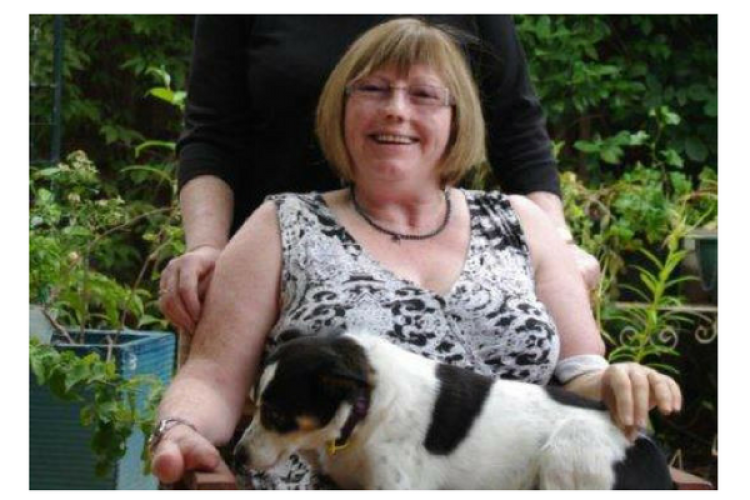- Home
- |
- About Us
- |
- News and Events
- |
- Resources
- |
- Contact
- |
- Donate today

My name is Angela. I have been a volunteer Peer Visitor with Limbs 4 Life since 2006.
In 1995 I developed Pneumococcal Septicaemia (blood poisoning). The infection developed very quickly, and caused gangrene in both my legs, and both arms. I had both legs amputated mid-calf, my left arm at mid-forearm, and all the fingers and half the thumb on my right hand.
Two months in the Austin was followed by eight months at Royal Talbot. Whilst in rehab, I learned how to drive again. I knew that this would be very important to my independence. Following my recovery, I returned to work part-time in Student Administration at La Trobe University, and fortunately the University was very supportive. I retired in 2008.
Any serious illness affects the whole family, and it was especially difficult for my husband and young children. Like many others, my body image was seriously damaged by this illness. It’s unfortunate that there wasn’t much research or information available at that time. I found Counselling to be very helpful. I believe that the excellent teamwork in the Austin and Talbot was essential to my survival, and for enabling me to learn how to function again.
I don’t have any phantom pain, thankfully. I walk without any kind of aid (I couldn’t hold a cane anyway). I have an electric wheelchair, for when I'm out and about shopping or going to the theatre. There are times when I develop blisters, or other problems with my prosthetic legs. This gets extremely frustrating, especially when repairs take weeks! This is not unusual with my arm, unfortunately, because repairs often have to be done in Germany.
For the first few years, I had lots of problems with blisters, excess sweating and all sorts of fitting problems with my legs. Gradually, the problems have become less.
I use an Otto Bock myo-electric arm, with a wrist-rotator. This has reasonable function, but because it is my ‘dominant’ hand, I do find that there are limits to what I can do with it. I go to Caulfield General Medical Centre for my arm.
It’s still quite difficult to get information at times, particularly about government supports. I am delighted that Melissa and her colleagues have worked so hard developing Limbs 4 Life. I am also delighted to be able to offer my support to new amputees. When I was in rehab, visitors with amputations made an enormous difference to my confidence. They helped me get ideas about what I could hope to achieve. There is clearly a need for an organisation to offer a formal program for peer visiting. Staff change in hospitals all the time, and in the past peer visiting was dependent on one of the therapists “knowing someone” with amputations, who was willing to come in. Limbs 4 Life has centralised this information, as well as arranging appropriate training for volunteers.
Since my retirement, I have become more involved in the community. For eight years I was president of Diamond Valley Community Support, www.dvsupport.org.au , and I now work very happily for two shifts each week in their op shops. I am a Consumer Representative on the Austin Hospital’s Deteriorating Patient Committee, which is fascinating and rewarding. It’s important for me to keep my mind stimulated, and I enjoy the interaction with people.
For the first few years, I had lots of problems with blisters, excess sweating and all sorts of fitting problems with my legs. Gradually, the problems have become less.
I use an Otto Bock myo-electric arm, with a wrist-rotator. This has reasonable function, but because it is my ‘dominant’ hand, I do find that there are limits to what I can do with it. I go to Caulfield General Medical Centre for my arm.
It’s still quite difficult to get information at times, particularly about government supports. I am delighted that Melissa and her colleagues have worked so hard developing Limbs 4 Life. I am also delighted to be able to offer my support to new amputees. When I was in rehab, visitors with amputations made an enormous difference to my confidence. They helped me get ideas about what I could hope to achieve. There is clearly a need for an organisation to offer a formal program for peer visiting. Staff change in hospitals all the time, and in the past peer visiting was dependent on one of the therapists “knowing someone” with amputations, who was willing to come in. Limbs 4 Life has centralised this information, as well as arranging appropriate training for volunteers.
Since my retirement, I have become more involved in the community. For eight years I was president of Diamond Valley Community Support, www.dvsupport.org.au , and I now work very happily for two shifts each week in their op shops. I am a Consumer Representative on the Austin Hospital’s Deteriorating Patient Committee, which is fascinating and rewarding. It’s important for me to keep my mind stimulated, and I enjoy the interaction with people.
Keep up to date with our latest news, events and information